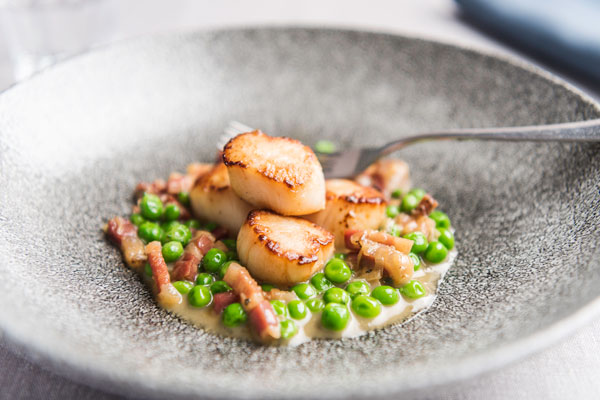Homegrown harvest: garden peas
Fresh or frozen, from mangetout to petit pois, peas can be used in everything from soups to panna cottas, says chef-consultant Russell Brown
The pop of a fresh pea pod is an immensely satisfying sound and fresh garden peas have a unique taste and texture. This in no way detracts from the frozen product, which certainly has its use in the commercial kitchen. For a pea soup or purée, for example, they are hard to beat. But fresh peas can really be classed as a separate product, with their firmer texture and more earthy, generally less sweet, flavour.
Historically, peas were eaten when they were more mature, and often it was the dried seed that was used. Garden peas became popular only in the 17th century.
Mangetout are underdeveloped peas, picked while the pods are still tender and the peas are small. Petit pois are also just small, young peas.
In the kitchen, peas can be used cooked or raw in a large range of dishes with origins from around the world. Pea soup is eaten in varying forms in many countries. Dried spilt peas are used in soups, pease pudding and dhals, marrowfat peas form the fish and chip shop staple mushy peas, and mangetout or sugar snaps often appear in stir fries. Dried peas are also roasted and salted as snacks. Fresh garden peas can be turned into purées, mousses or pancakes, and they can be added to salads, frittatas, curries, stews or pasta dishes. They can also be the star in dishes such as pea risottos, pea tarts and pea panna cottas.
At Winteringham Fields, in Lincolnshire, they have roast rump of Lincolnshire lamb, confit belly, new season minted peas and endive on the lunch menu, while Dom Chapman, at the Beehive in White Waltham, is serving a risotto of sweet young peas, broad beans, wild garlic and buffalo mozzarella.
Seared scallops with garden peas and pancetta
Serves 4 as a starter
2 thick rashers of pancetta or smoked streaky bacon, cut into lardons
1 large banana shallot, finely sliced
1 clove of garlic, finely sliced
25ml Noilly Prat
75ml dry white wine
200ml fresh vegetable stock
50g unsalted butter, cold and diced
Maldon sea salt and freshly ground black pepper
Lemon juice to taste
Extra virgin olive oil
8-16 scallops cleaned (quantity dependent on size)
100g blanched fresh peas
In a heavy-based pan, sauté the lardons until the fat starts to render, then add the shallots and garlic and continue to cook until the shallots are tender. Add the alcohols and reduce rapidly to about 25ml. Add the vegetable stock and again reduce rapidly until about 75ml of liquid remains. Gradually whisk in the butter, removing the pan from the heat as necessary to avoid the contents boiling. Once all the butter is incorporated, check the seasoning and adjust with salt, pepper
and the lemon juice. Heat a non-stick pan over a medium heat and add a little oil.
Season the scallops on one side only with Maldon sea salt and place carefully in the hot pan.
Start at 12 o'clock and add the scallops in a clockwise direction, leaning them up against each other. Cook for about a minute until nicely caramelised and then
turn over to cook the other side.
Again start at 12 o'clock, so theyare turned in the same order. While the scallops are cooking, add the peas to the ragoÁ»t pan and place over a gentle heat, just to warm through. Drain the scallops on kitchen paper, spoon the ragoÁ»t into the middle of four warm bowls and top with the scallops.
Egg tagliatelle with peas, chicory, lemon and pecorino
For the pasta
280-320g dried tagliatelle or
400g-500g fresh egg tagliatelle
For the sauce base
400ml fresh vegetable stock
50g crème fraÁ®che
Zest of 1 lemon and juice to taste
1 head of yellow chicory, plus the leaves, separated and finely sliced
200g fresh peas, blanched
80g Pecorino Romano
Maldon sea salt and freshly ground black pepper
To serve
Best quality extra virgin olive oil
Pecorino shavings
Peashoots
Cook the pasta in boiling salted water until al dente. You can use a good dried pasta or fresh egg pasta. In a deep sauté pan reduce the vegetable stock by half and then add the crème fraÁ®che and lemon zest. Add the chicory and cook for one minute. Drain the pasta, retaining some of the cooking water, and add to the sauce. Continue to cook for one minute, mixing the pasta to coat with the sauce. Add the peas and warm through for 30 seconds. Remove from the heat and stir in the Pecorino cheese. Season to taste with the lemon juice, Maldon salt and plenty of black pepper.
Divide between four bowls and scatter over some pea shoots and pecorino shavings. Drizzle over a generous amount of olive oil.
Buying and storage tips
•Pods should be crisp and full.
•Avoid overly large peas and pods that are wrinkled.
•Buy little and often.
•Keep unpodded peas refrigerated.
•Peas can also be blanched, refreshed in iced water and drained before storing in the fridge.
•Equal quantities of sugar and salt in the blanching water is a classic method with sweet vegetables.
Save
Save
Save
Continue reading
You need to be a premium member to view this. Subscribe from just 99p per week.
Already subscribed? Log In












